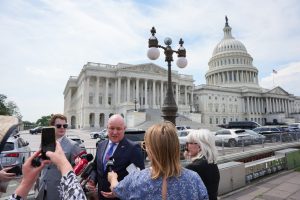Christopher Luxon is finding his foreign policy feet. Now eight months into the job, New Zealand’s prime minister is in Washington, D.C. this week to attend the NATO summit.
It is the third year in a row that Wellington has been invited to the annual gathering of the North Atlantic Treaty Organization, the West’s premier political and military alliance.
This year’s meeting – already carrying special weight by commemorating the 75th anniversary of NATO’s founding – looks set to be the most substantive summit yet in terms of New Zealand’s involvement.
New plans are being unveiled for NATO’s cooperation with its “Indo-Pacific 4” (or IP4) partners: Australia, Japan, New Zealand and South Korea. Four joint projects from the IP4 and NATO will focus on Ukraine, artificial intelligence, disinformation, and cybersecurity, according to U.S. officials.
This marks new territory for New Zealand – and something of a turnaround.
While it has twice before sent prime ministers to NATO summits, New Zealand’s previous Labour Government delayed formalizing expanded bilateral links with the alliance.
Australia, Japan, and South Korea all finalized “Individually Tailored Partnership Programmes” (or ITPPs) with NATO by last year – but New Zealand’s formal ties remained a work in progress.
This may have been driven by a degree of caution on the part of Jacinda Ardern and Chris Hipkins, who attended NATO as New Zealand prime ministers in 2022 and 2023, respectively.
Both Ardern and Hipkins were proponents of New Zealand’s “independent foreign policy.” The doctrine, developed after the U.S. downgraded ties with New Zealand in the 1980s, has seen New Zealand build strong relations with China.
A major reason for NATO’s invitation to the IP4 to its Madrid summit in 2022 was to support the launch of the alliance’s new long-term blueprint. The Strategic Concept openly called out China for its “stated ambitions and coercive policies” and pinpointed Beijing as a source of “systemic challenges” for the alliance.
After Ardern attended the 2022 NATO gathering, the Chinese Embassy in Wellington issued a statement noting Beijing’s opposition to “all kinds of military alliances, bloc politics, or exclusive small groups.”
Two years on, New Zealand has a new center-right government. Winston Peters, Luxon’s foreign minister, signaled in April that an ITPP was very much still on its way. Peters himself is known for his pro-U.S. views and more hawkish stance towards China.
China’s reaction to the new NATO-IP4 joint projects remains to be seen. But Beijing is unlikely to be mollified by the fact that the plans avoid any direct mention of China, given the trajectory of closer IP4-NATO cooperation.
Stronger ties with NATO may present particular geopolitical risks for Wellington. NATO is solely a political and military alliance; no companion trade deals are on offer. China has been New Zealand’s biggest trading partner since 2017, while access to most North American and European markets remains heavily restricted for New Zealand exporters.
Aware of the sensitivities of NATO’s interest in China, Christopher Luxon has been keen this week to put the focus on Ukraine – the subject of one of the new NATO-IP4 cooperation projects and tying in with this year’s overall summit theme, “Ukraine and transatlantic security.”
To that end, New Zealand’s prime minister has announced a modest new NZ$16 million package of aid for Kyiv, of which NZ$4 million appears to be for weaponry. The funds come on top of a NZ$26 million package announced in February, of which NZ$6.5 million was allocated for lethal aid.
The arms contributions are significant because under the previous Labour Government, Wellington had become reluctant to send Ukraine additional lethal aid (or money to purchase it) after making a one-off NZ$7.5 million contribution in April 2022.
After this week’s announcement, Luxon wrote on social media: “New Zealand understands that while we are distant from Ukraine, what happens there affects us all, and we are prepared to stand with Ukraine for the long haul.”
It was the prime minister’s second Ukraine-related post for the week.
By contrast, there was little publicity about New Zealand’s participation this week in a joint briefing published by a large number of NATO and IP4 security agencies, including New Zealand’s National Cyber Security Center. The 28-page publication focused on the “tradecraft” used in relation to Australia by “APT40,” defined as a “People’s Republic of China (PRC) state-sponsored cyber group.”
Given the advisory’s target and its authors, it seems very unlikely to be a coincidence that the document was released just prior to the NATO summit.
Stepping back, it is worth reflecting how this week’s NATO focus has shifted the spotlight away from the debate over whether Wellington will join AUKUS – the high-level defense pact that currently involves Australia, the United Kingdom and the United States.
Much ink has been spilled over the merits and drawbacks of New Zealand becoming a member of the ostensibly technology-focused “Pillar II” strand of AUKUS.
With time running out for New Zealand to join AUKUS before US elections in November, New Zealand’s Prime Minister may be turning the page.
For Christopher Luxon, AUKUS may not be needed at all.
A deeper partnership with NATO could be more than enough.
This article was originally published by the Democracy Project, which aims to enhance New Zealand’s democracy and public life by promoting critical thinking, analysis, debate, and engagement in politics and society.
































